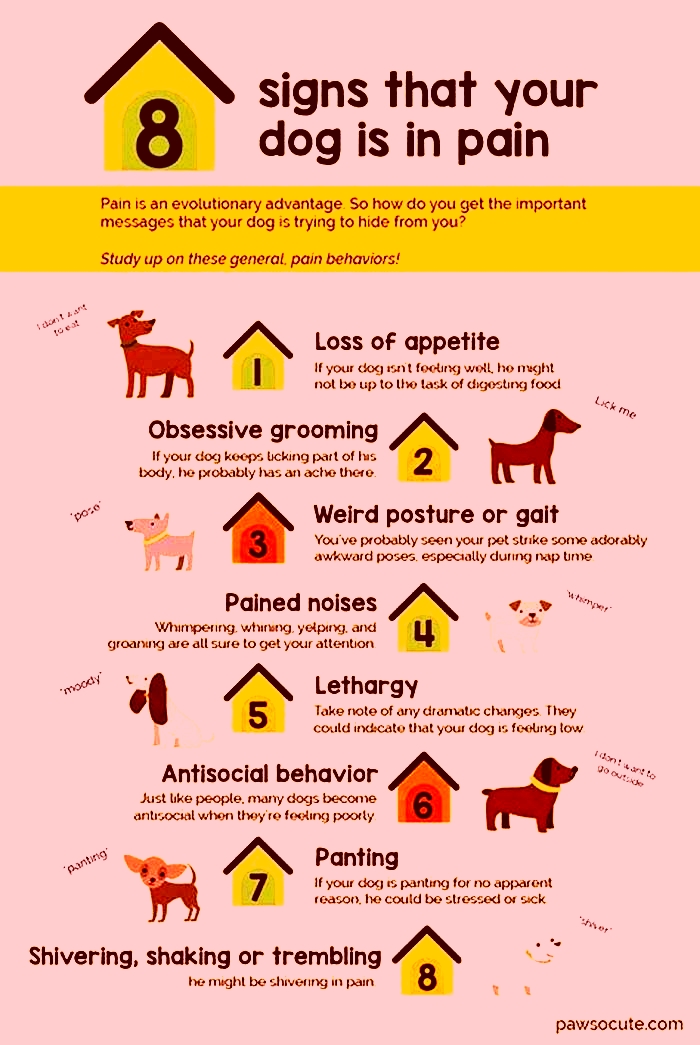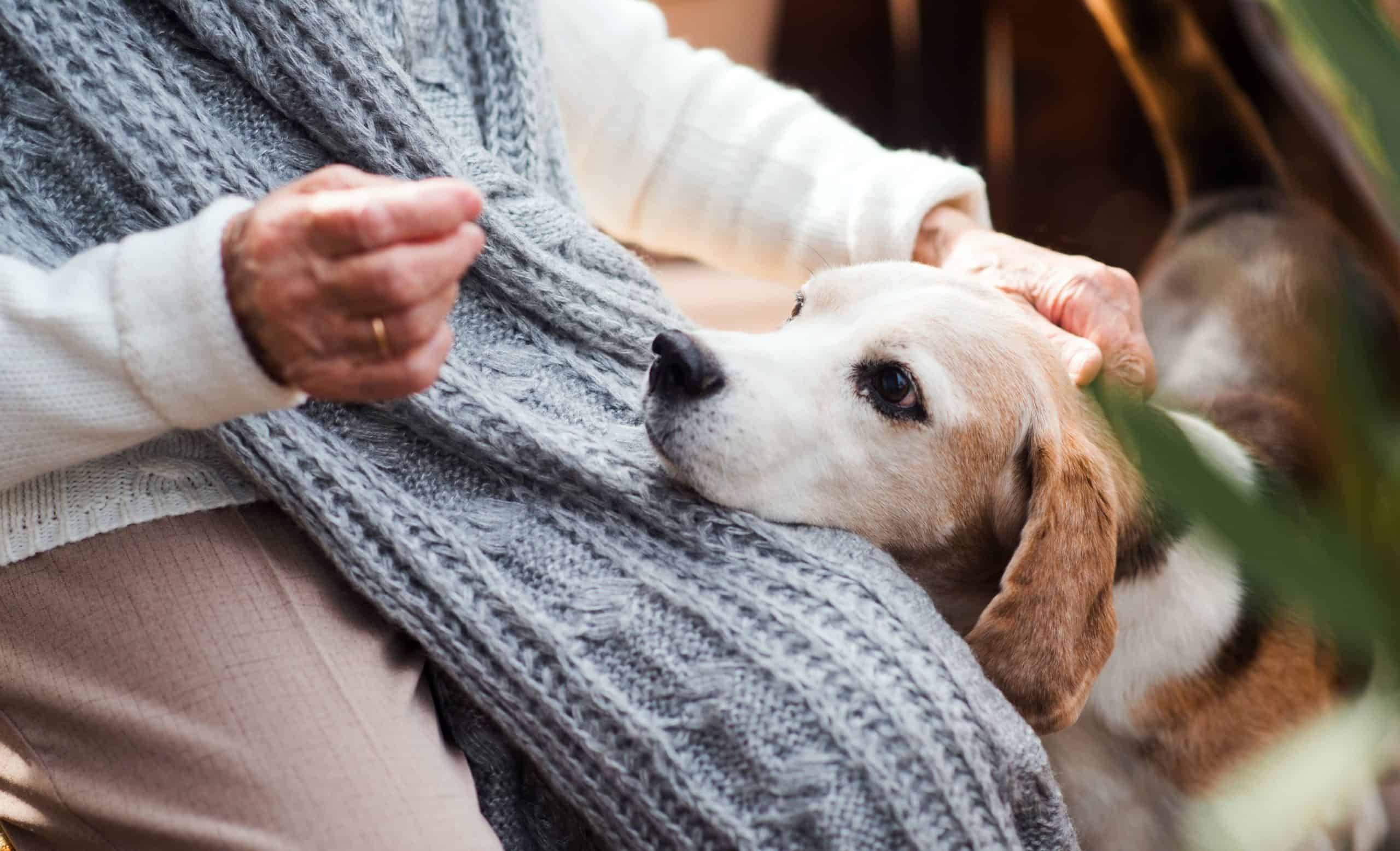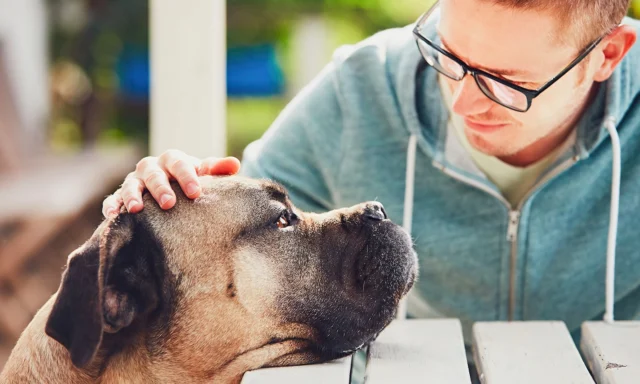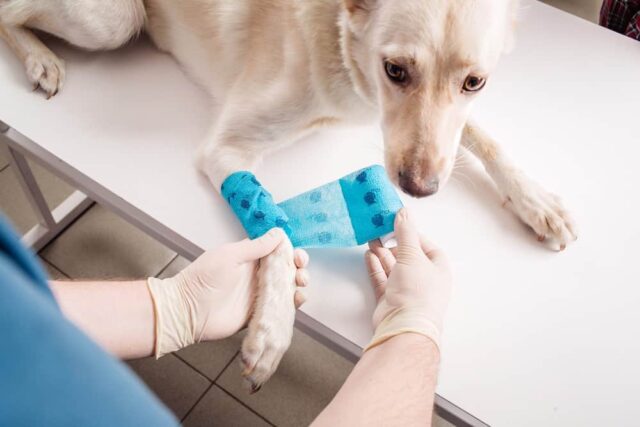What are three signs your dog is suffering

How Can You Tell if Your Dog is in Pain or Suffering?

When our dogs suffer, we suffer too, so we will do everything to make it easier for them and find out what is bothering them. The problem arises because dogs often hide their pain, so we cannot react in time. They are super enduring animals, which makes it hard to figure out if theyre suffering and from what. They also have this amazing ability to be happy for other people, even though theyre in great pain. The reason for this is the ancestors lived in the wilderness where pain was a sign of weakness, so they learned to hide it.
Some dogs will be happy to come to you and ask for help, but often when they are injured or sick they choose to come to you only when the pain becomes unbearable. This is precisely why you should pay special attention to their behavior and signs that may indicate pain.

How can you recognize their pain and suffering?
There are some behavioral signs that may indicate something is wrong with their health, which you should pay special attention to. Read below and find out what they are so you can help your furry friend on time.
Look for any sign of distress
If you have noticed your pet manifesting restless behavior, it is an indicator that it may be experiencing pain. Especially if it is constantly pacing back and forth, finds it difficult to get comfortable, or sleeps much less, it could be a red alarm pointing out that the pain is difficult to bear.
Changes in body and posture
The easiest sign which shows your dogs in pain is awkward body manifestations. Swelling of the paws, legs, and face is a sign of pain that can be caused by inflammation, infection, or even cancer. When they are in pain, some dogs have a very stiff and hunched posture, while others assume a position with their front legs on the ground and their rear in the air. They often adopt the so-called praying position when suffering from abdominal pain because it allows them to stretch that part of the body.

It shivers, shakes, or trembles
Shivering is not just a sign that it is cold or getting old. A dog that shakes or trembles can mean that it is in pain, or it could even be a symptom of something more serious such as poisoning, pancreatitis, or kidney disease. Dogs that have eaten large amounts of chocolate, moldy compost, or the sweetener xylitol often suffer from severe muscle tremors. So, make sure none of your kids were feeding it, sweets.
Limping
This symptom is very obvious and directly related to the existence of pain in a certain place. However, the causes can be different: in older dogs, the most common cause is arthritis, a disease that causes pain in the back and shoulders. These diseases are very common after 7-8 years and large dog breeds are prone to them. In these cases, pets often refuse to take the stairs or get up very slowly in the morning. When a dog gets old, it does not mean that it cannot be helped, so in such cases, take it to the vet who can suggest a medication which restores soft tissues, cartilage and joints, relieves pain and strengthens tendons.
Strong and bad breath
This symptom usually indicates a problem with the gastrointestinal tract, liver or kidneys. If the breath has a fruity smell and is accompanied by an excessive need to urinate, it may be a sign of diabetes. Odor that smells like urine can indicate that something is wrong with the dogs kidneys, while extremely unpleasant breath accompanied by yellowing of the whites of the eyes and lack of appetite indicates liver problems.

Stomach problems
Smaller problems with the stomach, intestines and digestion are not easily recognizable. Excessive drooling can be a good indicator of nausea, and phenomena such as vomiting, diarrhea or constipation certainly indicate that your pet has some kind of stomach problem. With such problems, help your pet with a probiotic for dogs prescribed by a professional vet, that can usually work after 60 minutes, stabilizing the intestinal flora and the level of desirable bacteria in the stomach.
Bad mood
Just like people, they too can be moody when theyre not feeling well. If your pet drastically changes its mood from a happy, playful, friendly one and starts behaving moody, grumpy, and even aggressive, it can be a sign that it is exposed to some pain and that its tolerance threshold is reduced or it does not want to be in pain.
Licking
Intense licking of certain parts of the body such as paw pads, a broken nail, some wound can be an indicator that something hurts in those places of the dog. This should not be ignored if an injury is not visible at first glance. Certain injuries such as a thorn, glass or parasite can be hidden deeper in the skin, so it is advisable to go to the vet.
When something bothers them or hurts them, dogs often, as we already mentioned, suffer in silence. Recognizing that a dog is in pain, whether from an injury or a health problem that is not easily visible, can be difficult because dogs do not have the ability to speak. However, above mentioned signs are more and less obvious, and may indicate that the dog is in pain. If you want to know how to help it, click here.

If you notice these signs, it is important not to try to treat your dog yourself. Many prescription medications for humans and pets can be very dangerous to dogs if taken without veterinary supervision. Therefore, it is important to consult a veterinarian and go with the dog for an examination. The following signs, i.e. changes in the dogs behavior, may indicate that the dog is in pain and needs help.
10 Signs of Rabies in Dogs and Three Prominent Stages
Rabies is a deadly preventable virus with almost 100% fatal outcomes in most cases (1).
If your dog becomes infected with rabies, there is little to no chance of survival, which is why vaccination is crucial (2).
Knowing about the signs of rabies in dogs may help you save your pet and yourself in some cases since rabies is a zoonotic disease (3).

What Is Rabies in Dogs?
Canine rabies is a virus that affects a dog's central nervous system, spinal cord, and brain (4). Sadly, both canine rabies and human rabies remain neglected and constantly reemerging diseases (5, 6).
The virus initially settles in the muscle tissue and moves to the dog's nervous system, ultimately entering saliva glands (7).
This is why most pictures of this disease show dogs drooling or foaming at the mouth, as in the dog rabies photo above.
The rabies virus will kill the animal host in nearly 100% of cases (8). The virus cannot survive for longer than 24 hours outside the host, either a human or a domestic or wild animal.
The virus has been detected in almost all countries globally (9). Around one million animals die of rabies annually. Even today, rabies kills around 60,000 people each year.

How Rabies Spreads?
Statistically, dogs are the most common carriers of rabies (10). Other common carriers of rabies are wild animals because they are not vaccinated, and rabies is most frequently found in foxes, bats, and raccoons (11).
Dogs themselves will most often get rabies through saliva coming out from another affected animal (12). It can be transmitted most easily by a dog bite.
Other transmission ways are also possible: eyes, nose, mouth, aerosol transmission, or organ transplantation, but they're much less common (13, 14, 15, 16).
Dogs are more prone to catching rabies if they have a scratch, laceration, or an open wound through which the virus can enter their body.
If you notice a dog with rabies symptoms in your neighborhood, you should report it immediately to the animal control center to stop the spread to other animals.
10 Signs of Rabies in Dogs
Signs of rabies in dogs do not always show up immediately. Rabies symptoms can appear after ten days from the infection or even a few months.
In some rare cases, the incubation period can last for a year (17).
During the no symptoms period, the virus is in its latent stage, where a dog usually behaves, and you cannot notice anything wrong with your pup.
There are three stages to rabies symptoms in dogs (18, 19). After being infected with rabies, your pet won't necessarily go through all of the below steps, and they may skip some of the symptoms.

1. The Initial Stage Symptoms
The first stage is where the symptoms are only starting to show differently.
Restlessness. A dog with rabies will have paranoia and behave as if they are constantly in fear or waiting for something terrible to happen.
Withdrawal. Dogs can become very shy and start hiding away from people, spending a lot of time alone.
Even if your dog is still friendly to you, they will lose their upbeat spirits and become melancholic.
Licking the Bite. If a virus carrier has bitten a dog, it will often lick, scratch, sniff, or bite infected wounds.
Aggression. Dogs with rabies can become unusually aggressive. Rabies aggression will show up in the initial stage, or it can come after the virus has reached a dog's nervous system.
The dog will bark at people and other animals, even inanimate things, and even try to bite them.

2. The Advanced Stage Symptoms
At this point, the virus has already reached the dog's brain and potentially affected the dog's spinal cord. This is when your pet will go through the aggression peak.
Furiousness. The dog will seem mad at times. They will bark at anything that passes by and attack other animals, people, and objects.
At this stage, a dog can also shoot their owner as if they do not recognize them anymore.
Dilated Pupils. If you look into a rabid dog's eyes, you will notice how their pupils are significantly dilated, as if they saw something scary.
It will be accompanied by a dog's sense of confusion and disorientation, even in a tight space.
Seizures. In the advanced rabies stage, your dog's muscles will become affected. You will see the dog trembling and shaking heavily. Ultimately, the affected dog can have one or several seizures.
Lack of Fear. A dog with rabies will have paranoia and increased aggressiveness, overshadowing their habitual behavior.
They will attack everything and anything since all the innate and learned fear will disappear due to the brain being cloudy from the virus.

3. The Final Stage Symptoms
This last stage of rabies signs in dogs will include the paralysis phase. The paralysis can start as partial and, after a few days, turn into complete paralysis, coma, and death.
It is also possible for a dog to skip the second stage entirely and enter this last one immediately after the first rabies symptoms.
Salivating. This is a common sign of a dog having rabies. Once the virus enters the saliva glands, it causes excessive drooling and drooling, which looks like foam.
The dog will seem unable to close its mouth, with the jaw dropping down fully. Additionally, the dog won't eat, and they will lose control over their throat.
Paralysis. The paralysis will affect the dog's mouth, throat, and muscles. The dog's body will start to tremble, and they can lose control over their legs and ability to walk.
The paralysis will quickly spread to the other parts of the dog's body, eventually leading to coma and death.
After the first signs of rabies in dogs appear, the animal will pass through the active stage of a virus within around seven days, as every phase is likely to last for approx. 2-3 days.
How to Prevent Rabies in Dogs?
The most effective way to prevent rabies in dogs is vaccination (20). Dogs that are vaccinated have a perfect chance of going through rabies unscathed.
Non-vaccinated dogs will almost certainly face death (21).
To minimize the risks, keep your pet away from stray dogs and wild animals (raccoons, foxes, bats), as they have the best chance of being carriers of rabies.
It's advisable to avoid unpopulated and uncontrolled natural areas like woods. Instead of going there, you can always walk your pup through a park.
Keep your dog on a leash during regular walks, especially when camping or hiking. Ensure your pet obeys the most basic obedience commands so you can control the dog in case they decides to chase after a raccoon or a fox.
Please spread the word about rabies, its symptoms, and its consequences among your neighbors, friends, and family dog owners.
If more people are aware of its seriousness, it is more likely that they will report suspicious cases and vaccinate their dogs.
If you see a dog or another animal on your street with symptoms of rabies, report it to the animal shelter or animal control center.
Never attempt to catch a suspicious or abandoned dog yourself, as you can be infected with rabies as well.
If you suspect that your dog has rabies, it is crucial to call your vet immediately. The dog will receive a rabies booster shot and be under observation for one to two months.
When taking your dog to the vet, remember to restrain them just in case.
If you can, avoid touching the dog, and if you have to, wear thick protective gloves. If your dog is drooling, do not come close to their mouth.
While transporting your dog to the vet, please keep them in a crate until the veterinarian takes over.
Signs of Rabies in Dogs Summary
Rabies is a severe virus with an almost specific fatal outcome for its host. It is usually transmitted by bite, saliva, and open wounds. The most common carriers of rabies are raccoons, bats, and foxes.
Signs of rabies in dogs range from the initial mild ones, such as restlessness and licking the wound, to the self-explanatory ones, like emphasized aggression, erratic behavior, and seizures, ending with the symptoms of foam at the mouth and complete paralysis.
To prevent rabies in your dog, always vaccinate them. It is also advisable to keep your pet away from wild and stray animals and raise awareness about the dangers of rabies.
READ NEXT:10 Things You Must Know About Dog Vaccines
Want to share this?




